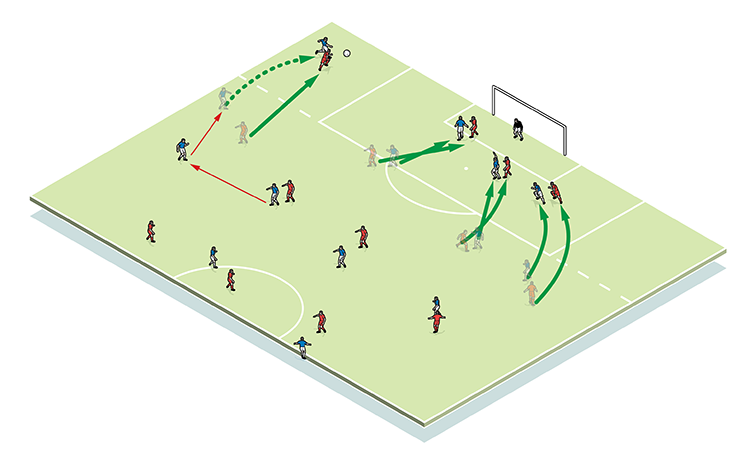You are viewing 1 of your 1 free articles
Position-specific possession
| Area | Half pitch |
| Equipment | Ball, cones, goal |
| No. of Players | 15 (7v7 plus neutral keeper) |
| Session Time | Main game 30mins, wide game 15mins |
This session looks at how players should adapt their possession habits depending on where they find themselves on the pitch.
Because the practice regularly causes players to change between attacking and defending principles, the need is there for them to be quick in reacting to opportunities to pass, dribble or shoot.
We find this an important session to run – both in terms of it providing players with a worthwhile mental challenge, and because it requires a tempo and pace that is similar to that found in match situations.
What do I get the players to do?
We play this on a half-pitch, using the width of the penalty area, with a goal at one end. This is 7v7 plus one neutral keeper. Offsides apply from the edge of the penalty area.
To start, the blue defender receives the ball from the keeper and moves forward linking with team mates with the aim of reaching the halfway line (1a), where his team turns around and attacks the goal. Midfielders and attackers break forward into space (1b).
1a

1b

If reds intercept, they can immediately attack the goal without having to run to the halfway line first (2).
2

Whether a shot misses the target, is saved, or results in a goal, the keeper plays a new ball out to the team who were out of possession (3); but any team receiving from the keeper can only score by taking the ball to the halfway line first.
3

What are the key things to look for technically/tactically?
Rotation and movement of players in midfield is important, along with efficient use of 1v1 scenarios on the wings, but measured playing out from the back is the key component of this practice. Players must use clever angles of passing and movement because the emphasis is on using possession for a specific reason – either in taking the ball to the halfway line or, having already done that, scoring a goal.
And a team losing possession must transition quickly because an attack will immediately come back towards them. Forwards need to backtrack to squeeze space while defenders must rapidly regroup into a structured backline.
How do I progress the session?
To progress, we limit the attacking team to two touches, with the exception of strikers who are encouraged to use as many touches as necessary in going 1v1 against opponents. This ensures rapid movement forward, with the need for supporting players to provide effective passing options.
How do I put this into a game situation?
We extend to full width and play 10v10, maintaining an offside line on the edge of the box (4a/4b).
4a

4b

Related Files
Editor's Picks
Using the goalkeeper in build-up play
Pressing principles
Intensive boxes drill with goals
Penetrating the final third
Creating and finishing
My philosophy
Pressing initiation
Compact team movement
Defensive organisation
Coaches' Testimonials

Alan Pardew

Arsène Wenger

Brendan Rodgers

Carlos Carvalhal

José Mourinho

Jürgen Klopp

Pep Guardiola

Roy Hodgson

Sir Alex Ferguson

Steven Gerrard
Coaches' Testimonials

Gerald Kearney, Downtown Las Vegas Soccer Club

Paul Butler, Florida, USA

Rick Shields, Springboro, USA

Tony Green, Pierrefonds Titans, Quebec, Canada
Join the world's leading coaches and managers and discover for yourself one of the best kept secrets in coaching. No other training tool on the planet is written or read by the calibre of names you’ll find in Elite Soccer.
In a recent survey 92% of subscribers said Elite Soccer makes them more confident, 89% said it makes them a more effective coach and 91% said it makes them more inspired.
Get Monthly Inspiration
All the latest techniques and approaches
Since 2010 Elite Soccer has given subscribers exclusive insight into the training ground practices of the world’s best coaches. Published in partnership with the League Managers Association we have unparalleled access to the leading lights in the English leagues, as well as a host of international managers.
Elite Soccer exclusively features sessions written by the coaches themselves. There are no observed sessions and no sessions “in the style of”, just first-hand advice delivered direct to you from the coach.









